Learned Helplessness: Analyzing Response, Outcome, and Controllability
VerifiedAdded on 2023/06/10
|9
|1975
|437
Essay
AI Summary
This essay delves into the concept of learned helplessness, examining its roots, influencing factors, and impact on individuals. It begins by defining learned helplessness as a response to uncontrollable situations, drawing on the foundational work of Seligman and Maier. The essay explores various factors that contribute to learned helplessness, including controllability, work efficiency, and parental attitude. It discusses how individuals with learned helplessness may perceive success as a matter of luck rather than effort, and how early socialization, particularly in eastern cultures, can play a significant role. The essay also presents hypotheses related to problem-solving abilities and task perception under varying conditions of difficulty, highlighting the potential for frustration and resignation in individuals experiencing learned helplessness. The study references various research works that contribute to the understanding and analysis of learned helplessness in different contexts.
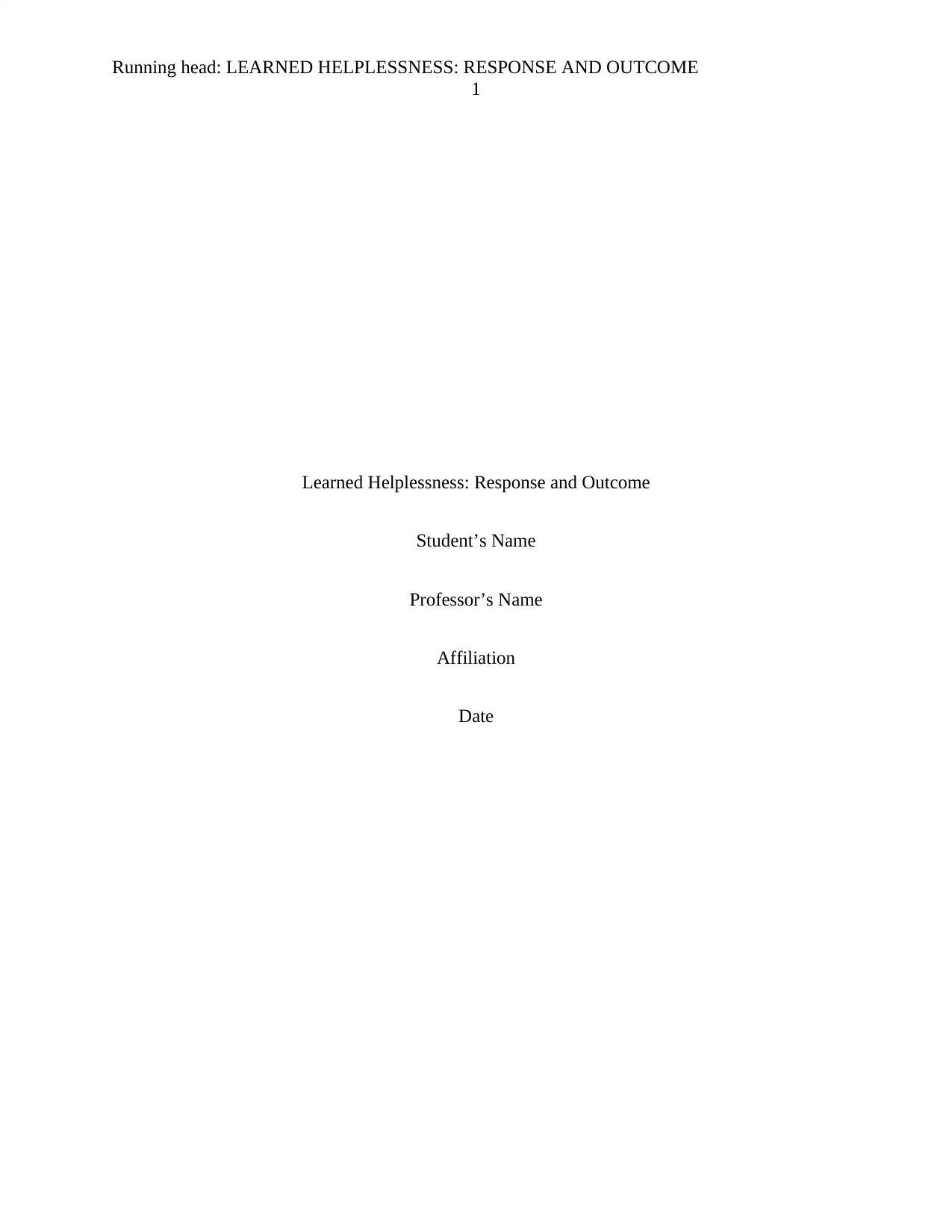
Running head: LEARNED HELPLESSNESS: RESPONSE AND OUTCOME
1
Learned Helplessness: Response and Outcome
Student’s Name
Professor’s Name
Affiliation
Date
1
Learned Helplessness: Response and Outcome
Student’s Name
Professor’s Name
Affiliation
Date
Paraphrase This Document
Need a fresh take? Get an instant paraphrase of this document with our AI Paraphraser
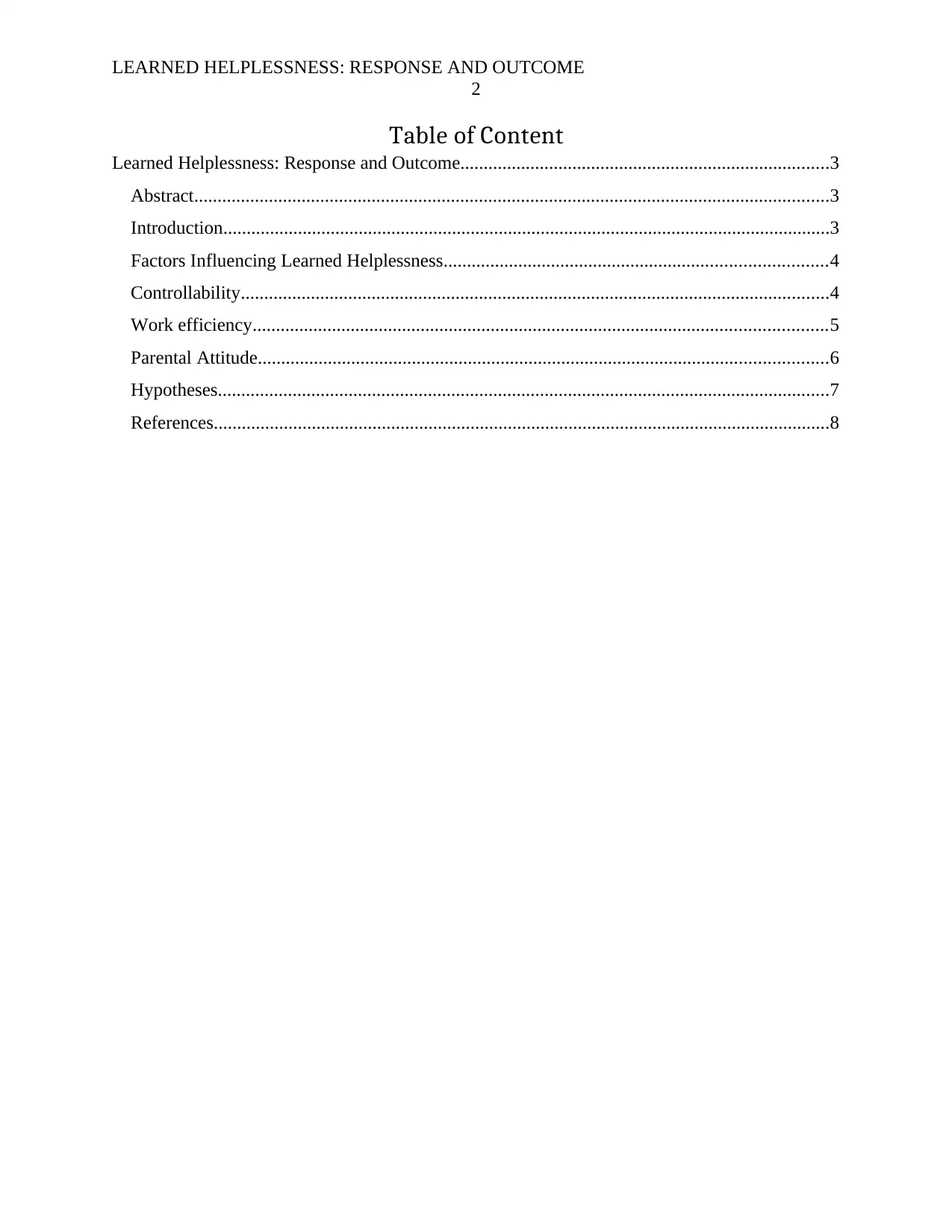
LEARNED HELPLESSNESS: RESPONSE AND OUTCOME
2
Table of Content
Learned Helplessness: Response and Outcome...............................................................................3
Abstract........................................................................................................................................3
Introduction..................................................................................................................................3
Factors Influencing Learned Helplessness..................................................................................4
Controllability..............................................................................................................................4
Work efficiency...........................................................................................................................5
Parental Attitude..........................................................................................................................6
Hypotheses...................................................................................................................................7
References....................................................................................................................................8
2
Table of Content
Learned Helplessness: Response and Outcome...............................................................................3
Abstract........................................................................................................................................3
Introduction..................................................................................................................................3
Factors Influencing Learned Helplessness..................................................................................4
Controllability..............................................................................................................................4
Work efficiency...........................................................................................................................5
Parental Attitude..........................................................................................................................6
Hypotheses...................................................................................................................................7
References....................................................................................................................................8
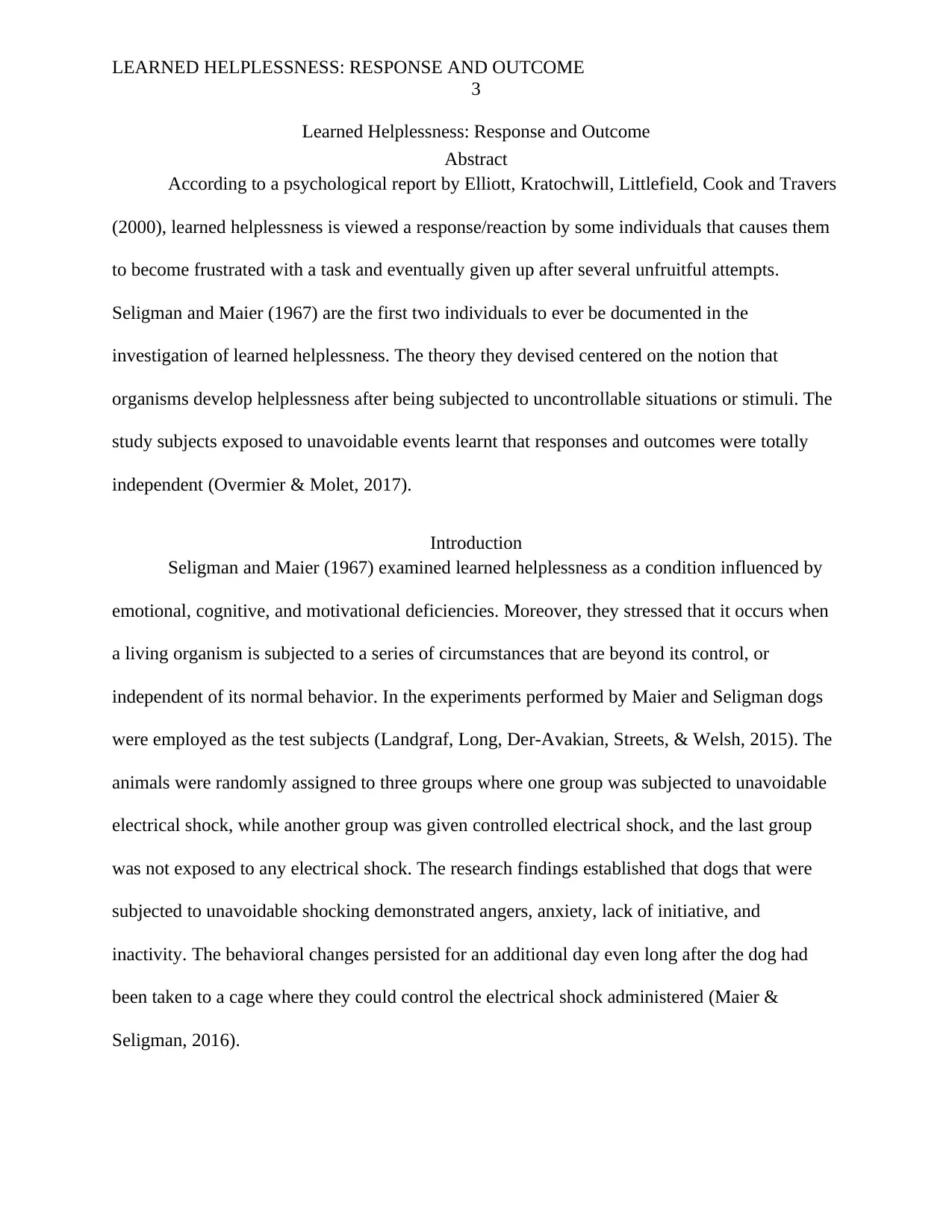
LEARNED HELPLESSNESS: RESPONSE AND OUTCOME
3
Learned Helplessness: Response and Outcome
Abstract
According to a psychological report by Elliott, Kratochwill, Littlefield, Cook and Travers
(2000), learned helplessness is viewed a response/reaction by some individuals that causes them
to become frustrated with a task and eventually given up after several unfruitful attempts.
Seligman and Maier (1967) are the first two individuals to ever be documented in the
investigation of learned helplessness. The theory they devised centered on the notion that
organisms develop helplessness after being subjected to uncontrollable situations or stimuli. The
study subjects exposed to unavoidable events learnt that responses and outcomes were totally
independent (Overmier & Molet, 2017).
Introduction
Seligman and Maier (1967) examined learned helplessness as a condition influenced by
emotional, cognitive, and motivational deficiencies. Moreover, they stressed that it occurs when
a living organism is subjected to a series of circumstances that are beyond its control, or
independent of its normal behavior. In the experiments performed by Maier and Seligman dogs
were employed as the test subjects (Landgraf, Long, Der-Avakian, Streets, & Welsh, 2015). The
animals were randomly assigned to three groups where one group was subjected to unavoidable
electrical shock, while another group was given controlled electrical shock, and the last group
was not exposed to any electrical shock. The research findings established that dogs that were
subjected to unavoidable shocking demonstrated angers, anxiety, lack of initiative, and
inactivity. The behavioral changes persisted for an additional day even long after the dog had
been taken to a cage where they could control the electrical shock administered (Maier &
Seligman, 2016).
3
Learned Helplessness: Response and Outcome
Abstract
According to a psychological report by Elliott, Kratochwill, Littlefield, Cook and Travers
(2000), learned helplessness is viewed a response/reaction by some individuals that causes them
to become frustrated with a task and eventually given up after several unfruitful attempts.
Seligman and Maier (1967) are the first two individuals to ever be documented in the
investigation of learned helplessness. The theory they devised centered on the notion that
organisms develop helplessness after being subjected to uncontrollable situations or stimuli. The
study subjects exposed to unavoidable events learnt that responses and outcomes were totally
independent (Overmier & Molet, 2017).
Introduction
Seligman and Maier (1967) examined learned helplessness as a condition influenced by
emotional, cognitive, and motivational deficiencies. Moreover, they stressed that it occurs when
a living organism is subjected to a series of circumstances that are beyond its control, or
independent of its normal behavior. In the experiments performed by Maier and Seligman dogs
were employed as the test subjects (Landgraf, Long, Der-Avakian, Streets, & Welsh, 2015). The
animals were randomly assigned to three groups where one group was subjected to unavoidable
electrical shock, while another group was given controlled electrical shock, and the last group
was not exposed to any electrical shock. The research findings established that dogs that were
subjected to unavoidable shocking demonstrated angers, anxiety, lack of initiative, and
inactivity. The behavioral changes persisted for an additional day even long after the dog had
been taken to a cage where they could control the electrical shock administered (Maier &
Seligman, 2016).
⊘ This is a preview!⊘
Do you want full access?
Subscribe today to unlock all pages.

Trusted by 1+ million students worldwide
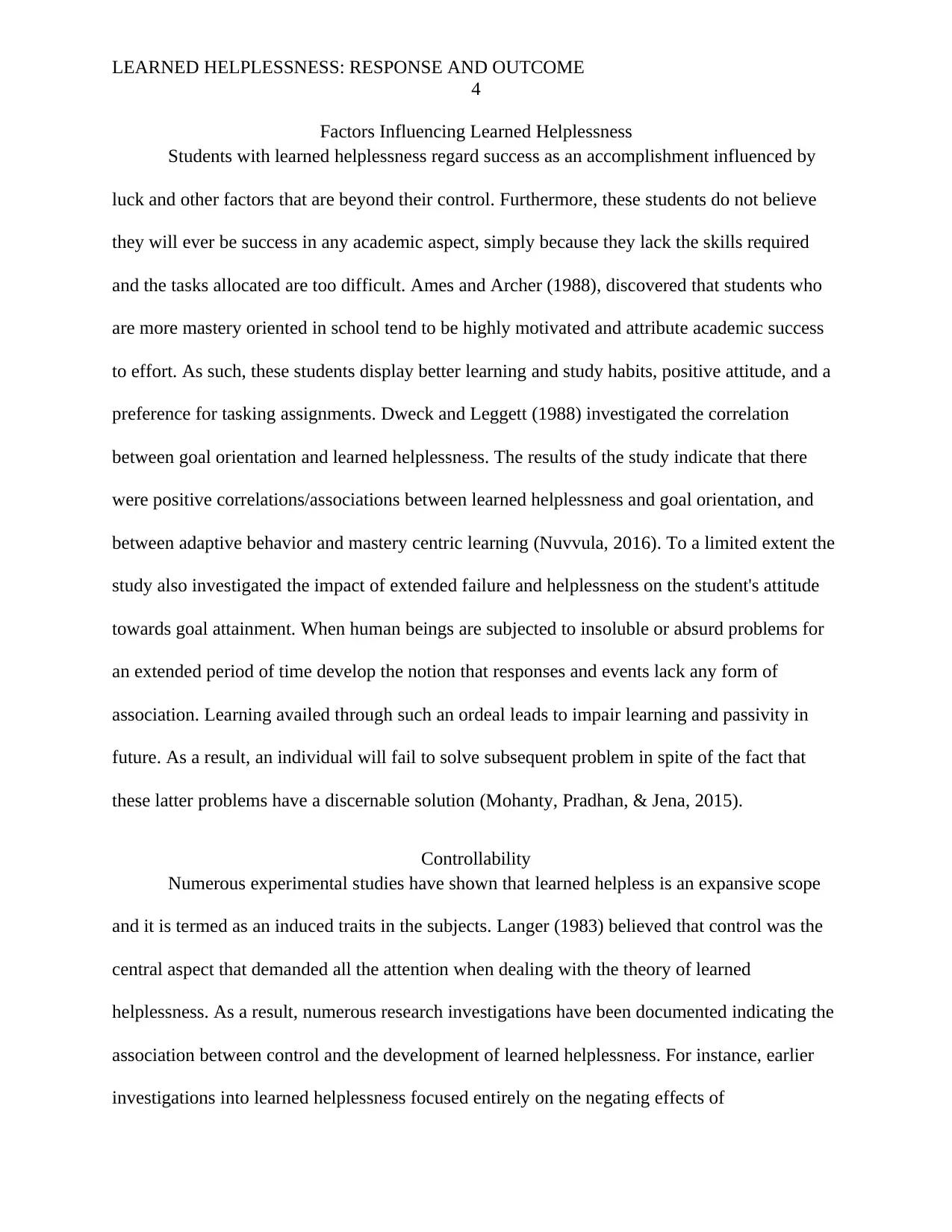
LEARNED HELPLESSNESS: RESPONSE AND OUTCOME
4
Factors Influencing Learned Helplessness
Students with learned helplessness regard success as an accomplishment influenced by
luck and other factors that are beyond their control. Furthermore, these students do not believe
they will ever be success in any academic aspect, simply because they lack the skills required
and the tasks allocated are too difficult. Ames and Archer (1988), discovered that students who
are more mastery oriented in school tend to be highly motivated and attribute academic success
to effort. As such, these students display better learning and study habits, positive attitude, and a
preference for tasking assignments. Dweck and Leggett (1988) investigated the correlation
between goal orientation and learned helplessness. The results of the study indicate that there
were positive correlations/associations between learned helplessness and goal orientation, and
between adaptive behavior and mastery centric learning (Nuvvula, 2016). To a limited extent the
study also investigated the impact of extended failure and helplessness on the student's attitude
towards goal attainment. When human beings are subjected to insoluble or absurd problems for
an extended period of time develop the notion that responses and events lack any form of
association. Learning availed through such an ordeal leads to impair learning and passivity in
future. As a result, an individual will fail to solve subsequent problem in spite of the fact that
these latter problems have a discernable solution (Mohanty, Pradhan, & Jena, 2015).
Controllability
Numerous experimental studies have shown that learned helpless is an expansive scope
and it is termed as an induced traits in the subjects. Langer (1983) believed that control was the
central aspect that demanded all the attention when dealing with the theory of learned
helplessness. As a result, numerous research investigations have been documented indicating the
association between control and the development of learned helplessness. For instance, earlier
investigations into learned helplessness focused entirely on the negating effects of
4
Factors Influencing Learned Helplessness
Students with learned helplessness regard success as an accomplishment influenced by
luck and other factors that are beyond their control. Furthermore, these students do not believe
they will ever be success in any academic aspect, simply because they lack the skills required
and the tasks allocated are too difficult. Ames and Archer (1988), discovered that students who
are more mastery oriented in school tend to be highly motivated and attribute academic success
to effort. As such, these students display better learning and study habits, positive attitude, and a
preference for tasking assignments. Dweck and Leggett (1988) investigated the correlation
between goal orientation and learned helplessness. The results of the study indicate that there
were positive correlations/associations between learned helplessness and goal orientation, and
between adaptive behavior and mastery centric learning (Nuvvula, 2016). To a limited extent the
study also investigated the impact of extended failure and helplessness on the student's attitude
towards goal attainment. When human beings are subjected to insoluble or absurd problems for
an extended period of time develop the notion that responses and events lack any form of
association. Learning availed through such an ordeal leads to impair learning and passivity in
future. As a result, an individual will fail to solve subsequent problem in spite of the fact that
these latter problems have a discernable solution (Mohanty, Pradhan, & Jena, 2015).
Controllability
Numerous experimental studies have shown that learned helpless is an expansive scope
and it is termed as an induced traits in the subjects. Langer (1983) believed that control was the
central aspect that demanded all the attention when dealing with the theory of learned
helplessness. As a result, numerous research investigations have been documented indicating the
association between control and the development of learned helplessness. For instance, earlier
investigations into learned helplessness focused entirely on the negating effects of
Paraphrase This Document
Need a fresh take? Get an instant paraphrase of this document with our AI Paraphraser
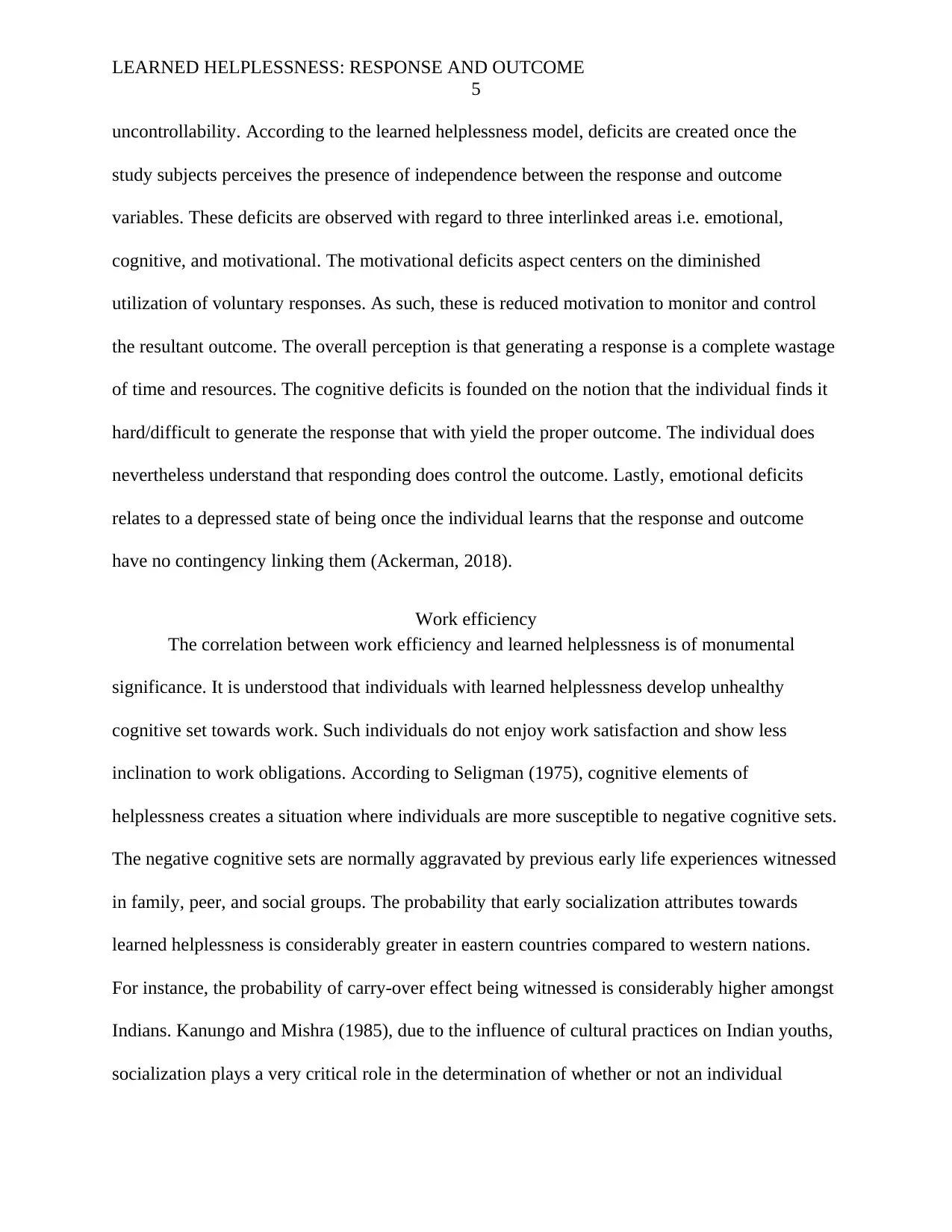
LEARNED HELPLESSNESS: RESPONSE AND OUTCOME
5
uncontrollability. According to the learned helplessness model, deficits are created once the
study subjects perceives the presence of independence between the response and outcome
variables. These deficits are observed with regard to three interlinked areas i.e. emotional,
cognitive, and motivational. The motivational deficits aspect centers on the diminished
utilization of voluntary responses. As such, these is reduced motivation to monitor and control
the resultant outcome. The overall perception is that generating a response is a complete wastage
of time and resources. The cognitive deficits is founded on the notion that the individual finds it
hard/difficult to generate the response that with yield the proper outcome. The individual does
nevertheless understand that responding does control the outcome. Lastly, emotional deficits
relates to a depressed state of being once the individual learns that the response and outcome
have no contingency linking them (Ackerman, 2018).
Work efficiency
The correlation between work efficiency and learned helplessness is of monumental
significance. It is understood that individuals with learned helplessness develop unhealthy
cognitive set towards work. Such individuals do not enjoy work satisfaction and show less
inclination to work obligations. According to Seligman (1975), cognitive elements of
helplessness creates a situation where individuals are more susceptible to negative cognitive sets.
The negative cognitive sets are normally aggravated by previous early life experiences witnessed
in family, peer, and social groups. The probability that early socialization attributes towards
learned helplessness is considerably greater in eastern countries compared to western nations.
For instance, the probability of carry-over effect being witnessed is considerably higher amongst
Indians. Kanungo and Mishra (1985), due to the influence of cultural practices on Indian youths,
socialization plays a very critical role in the determination of whether or not an individual
5
uncontrollability. According to the learned helplessness model, deficits are created once the
study subjects perceives the presence of independence between the response and outcome
variables. These deficits are observed with regard to three interlinked areas i.e. emotional,
cognitive, and motivational. The motivational deficits aspect centers on the diminished
utilization of voluntary responses. As such, these is reduced motivation to monitor and control
the resultant outcome. The overall perception is that generating a response is a complete wastage
of time and resources. The cognitive deficits is founded on the notion that the individual finds it
hard/difficult to generate the response that with yield the proper outcome. The individual does
nevertheless understand that responding does control the outcome. Lastly, emotional deficits
relates to a depressed state of being once the individual learns that the response and outcome
have no contingency linking them (Ackerman, 2018).
Work efficiency
The correlation between work efficiency and learned helplessness is of monumental
significance. It is understood that individuals with learned helplessness develop unhealthy
cognitive set towards work. Such individuals do not enjoy work satisfaction and show less
inclination to work obligations. According to Seligman (1975), cognitive elements of
helplessness creates a situation where individuals are more susceptible to negative cognitive sets.
The negative cognitive sets are normally aggravated by previous early life experiences witnessed
in family, peer, and social groups. The probability that early socialization attributes towards
learned helplessness is considerably greater in eastern countries compared to western nations.
For instance, the probability of carry-over effect being witnessed is considerably higher amongst
Indians. Kanungo and Mishra (1985), due to the influence of cultural practices on Indian youths,
socialization plays a very critical role in the determination of whether or not an individual
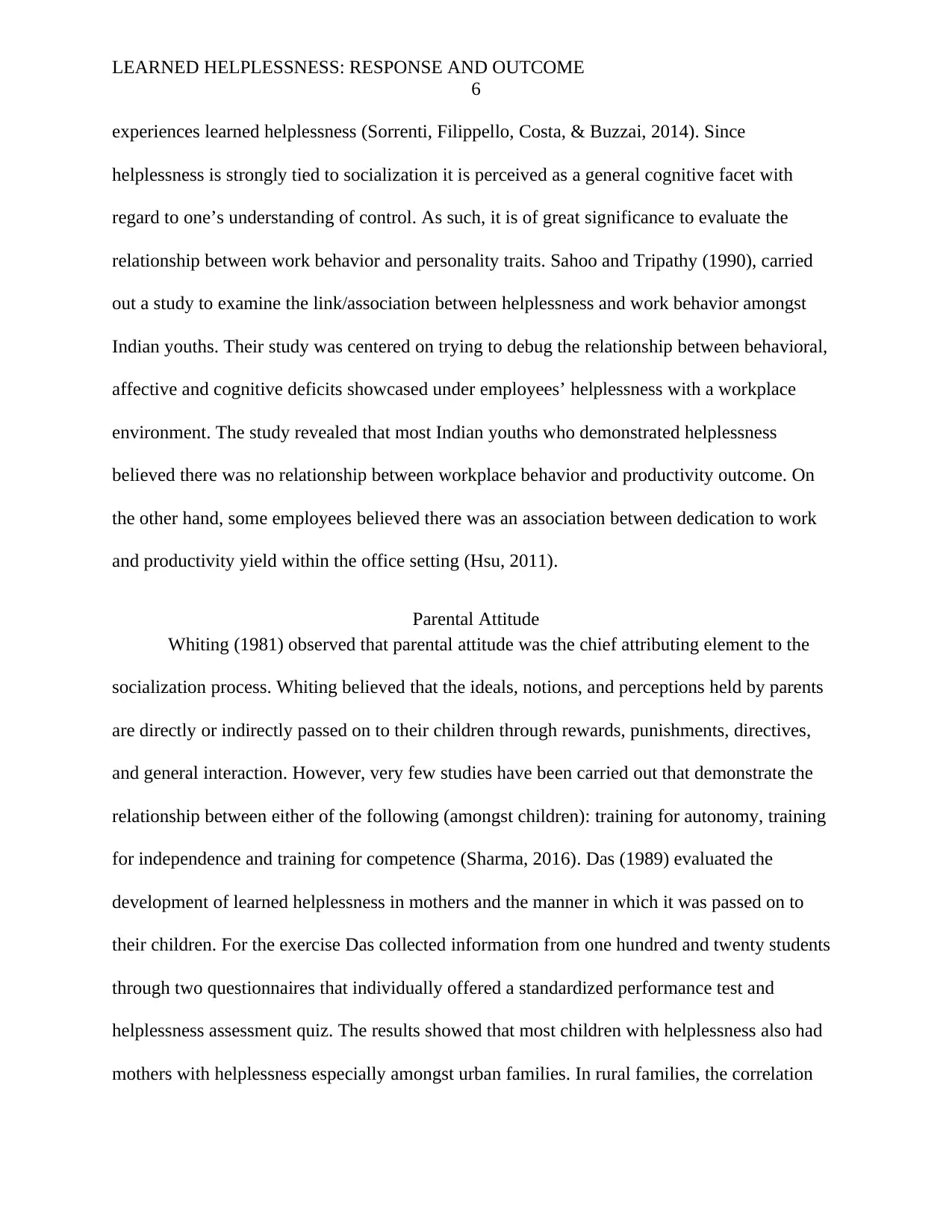
LEARNED HELPLESSNESS: RESPONSE AND OUTCOME
6
experiences learned helplessness (Sorrenti, Filippello, Costa, & Buzzai, 2014). Since
helplessness is strongly tied to socialization it is perceived as a general cognitive facet with
regard to one’s understanding of control. As such, it is of great significance to evaluate the
relationship between work behavior and personality traits. Sahoo and Tripathy (1990), carried
out a study to examine the link/association between helplessness and work behavior amongst
Indian youths. Their study was centered on trying to debug the relationship between behavioral,
affective and cognitive deficits showcased under employees’ helplessness with a workplace
environment. The study revealed that most Indian youths who demonstrated helplessness
believed there was no relationship between workplace behavior and productivity outcome. On
the other hand, some employees believed there was an association between dedication to work
and productivity yield within the office setting (Hsu, 2011).
Parental Attitude
Whiting (1981) observed that parental attitude was the chief attributing element to the
socialization process. Whiting believed that the ideals, notions, and perceptions held by parents
are directly or indirectly passed on to their children through rewards, punishments, directives,
and general interaction. However, very few studies have been carried out that demonstrate the
relationship between either of the following (amongst children): training for autonomy, training
for independence and training for competence (Sharma, 2016). Das (1989) evaluated the
development of learned helplessness in mothers and the manner in which it was passed on to
their children. For the exercise Das collected information from one hundred and twenty students
through two questionnaires that individually offered a standardized performance test and
helplessness assessment quiz. The results showed that most children with helplessness also had
mothers with helplessness especially amongst urban families. In rural families, the correlation
6
experiences learned helplessness (Sorrenti, Filippello, Costa, & Buzzai, 2014). Since
helplessness is strongly tied to socialization it is perceived as a general cognitive facet with
regard to one’s understanding of control. As such, it is of great significance to evaluate the
relationship between work behavior and personality traits. Sahoo and Tripathy (1990), carried
out a study to examine the link/association between helplessness and work behavior amongst
Indian youths. Their study was centered on trying to debug the relationship between behavioral,
affective and cognitive deficits showcased under employees’ helplessness with a workplace
environment. The study revealed that most Indian youths who demonstrated helplessness
believed there was no relationship between workplace behavior and productivity outcome. On
the other hand, some employees believed there was an association between dedication to work
and productivity yield within the office setting (Hsu, 2011).
Parental Attitude
Whiting (1981) observed that parental attitude was the chief attributing element to the
socialization process. Whiting believed that the ideals, notions, and perceptions held by parents
are directly or indirectly passed on to their children through rewards, punishments, directives,
and general interaction. However, very few studies have been carried out that demonstrate the
relationship between either of the following (amongst children): training for autonomy, training
for independence and training for competence (Sharma, 2016). Das (1989) evaluated the
development of learned helplessness in mothers and the manner in which it was passed on to
their children. For the exercise Das collected information from one hundred and twenty students
through two questionnaires that individually offered a standardized performance test and
helplessness assessment quiz. The results showed that most children with helplessness also had
mothers with helplessness especially amongst urban families. In rural families, the correlation
⊘ This is a preview!⊘
Do you want full access?
Subscribe today to unlock all pages.

Trusted by 1+ million students worldwide
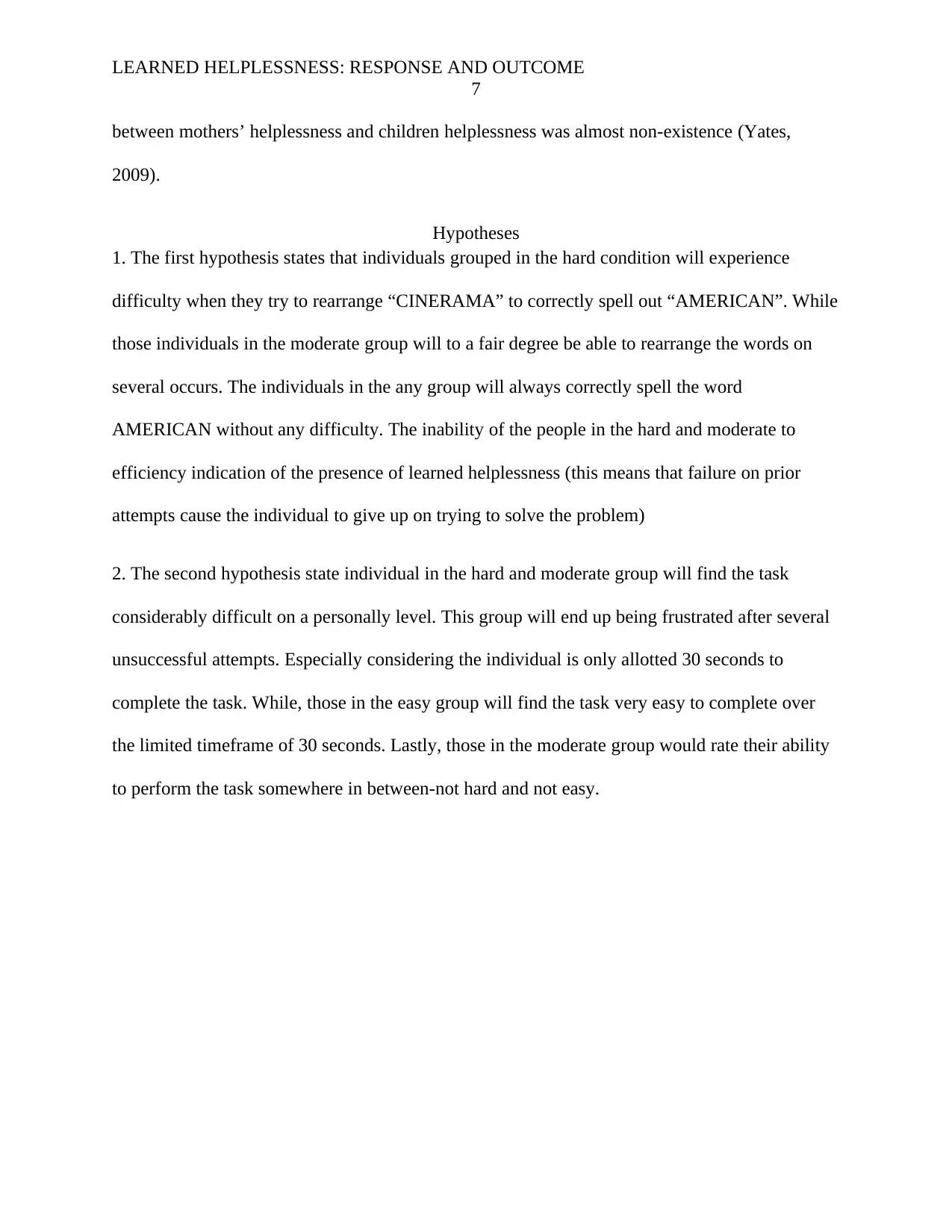
LEARNED HELPLESSNESS: RESPONSE AND OUTCOME
7
between mothers’ helplessness and children helplessness was almost non-existence (Yates,
2009).
Hypotheses
1. The first hypothesis states that individuals grouped in the hard condition will experience
difficulty when they try to rearrange “CINERAMA” to correctly spell out “AMERICAN”. While
those individuals in the moderate group will to a fair degree be able to rearrange the words on
several occurs. The individuals in the any group will always correctly spell the word
AMERICAN without any difficulty. The inability of the people in the hard and moderate to
efficiency indication of the presence of learned helplessness (this means that failure on prior
attempts cause the individual to give up on trying to solve the problem)
2. The second hypothesis state individual in the hard and moderate group will find the task
considerably difficult on a personally level. This group will end up being frustrated after several
unsuccessful attempts. Especially considering the individual is only allotted 30 seconds to
complete the task. While, those in the easy group will find the task very easy to complete over
the limited timeframe of 30 seconds. Lastly, those in the moderate group would rate their ability
to perform the task somewhere in between-not hard and not easy.
7
between mothers’ helplessness and children helplessness was almost non-existence (Yates,
2009).
Hypotheses
1. The first hypothesis states that individuals grouped in the hard condition will experience
difficulty when they try to rearrange “CINERAMA” to correctly spell out “AMERICAN”. While
those individuals in the moderate group will to a fair degree be able to rearrange the words on
several occurs. The individuals in the any group will always correctly spell the word
AMERICAN without any difficulty. The inability of the people in the hard and moderate to
efficiency indication of the presence of learned helplessness (this means that failure on prior
attempts cause the individual to give up on trying to solve the problem)
2. The second hypothesis state individual in the hard and moderate group will find the task
considerably difficult on a personally level. This group will end up being frustrated after several
unsuccessful attempts. Especially considering the individual is only allotted 30 seconds to
complete the task. While, those in the easy group will find the task very easy to complete over
the limited timeframe of 30 seconds. Lastly, those in the moderate group would rate their ability
to perform the task somewhere in between-not hard and not easy.
Paraphrase This Document
Need a fresh take? Get an instant paraphrase of this document with our AI Paraphraser
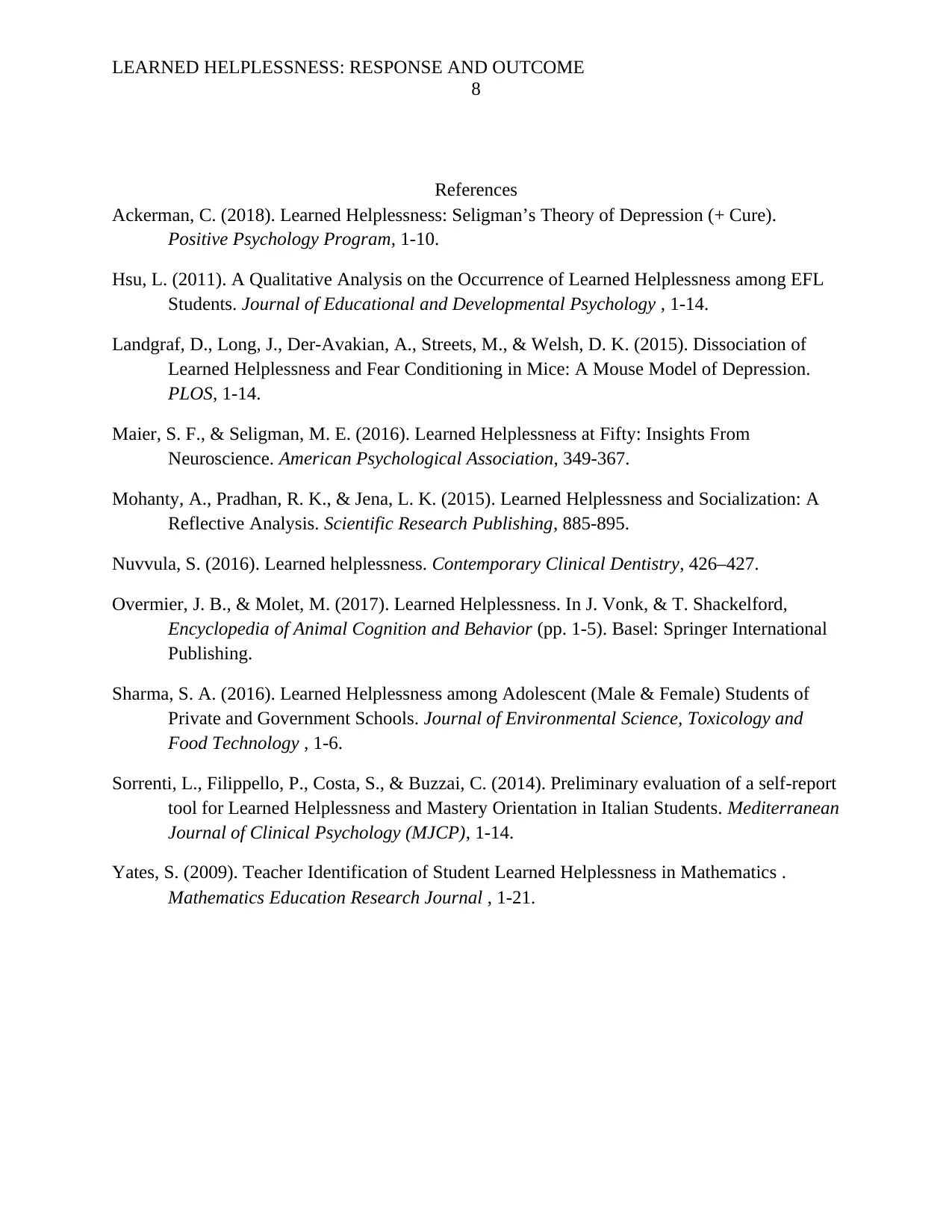
LEARNED HELPLESSNESS: RESPONSE AND OUTCOME
8
References
Ackerman, C. (2018). Learned Helplessness: Seligman’s Theory of Depression (+ Cure).
Positive Psychology Program, 1-10.
Hsu, L. (2011). A Qualitative Analysis on the Occurrence of Learned Helplessness among EFL
Students. Journal of Educational and Developmental Psychology , 1-14.
Landgraf, D., Long, J., Der-Avakian, A., Streets, M., & Welsh, D. K. (2015). Dissociation of
Learned Helplessness and Fear Conditioning in Mice: A Mouse Model of Depression.
PLOS, 1-14.
Maier, S. F., & Seligman, M. E. (2016). Learned Helplessness at Fifty: Insights From
Neuroscience. American Psychological Association, 349-367.
Mohanty, A., Pradhan, R. K., & Jena, L. K. (2015). Learned Helplessness and Socialization: A
Reflective Analysis. Scientific Research Publishing, 885-895.
Nuvvula, S. (2016). Learned helplessness. Contemporary Clinical Dentistry, 426–427.
Overmier, J. B., & Molet, M. (2017). Learned Helplessness. In J. Vonk, & T. Shackelford,
Encyclopedia of Animal Cognition and Behavior (pp. 1-5). Basel: Springer International
Publishing.
Sharma, S. A. (2016). Learned Helplessness among Adolescent (Male & Female) Students of
Private and Government Schools. Journal of Environmental Science, Toxicology and
Food Technology , 1-6.
Sorrenti, L., Filippello, P., Costa, S., & Buzzai, C. (2014). Preliminary evaluation of a self-report
tool for Learned Helplessness and Mastery Orientation in Italian Students. Mediterranean
Journal of Clinical Psychology (MJCP), 1-14.
Yates, S. (2009). Teacher Identification of Student Learned Helplessness in Mathematics .
Mathematics Education Research Journal , 1-21.
8
References
Ackerman, C. (2018). Learned Helplessness: Seligman’s Theory of Depression (+ Cure).
Positive Psychology Program, 1-10.
Hsu, L. (2011). A Qualitative Analysis on the Occurrence of Learned Helplessness among EFL
Students. Journal of Educational and Developmental Psychology , 1-14.
Landgraf, D., Long, J., Der-Avakian, A., Streets, M., & Welsh, D. K. (2015). Dissociation of
Learned Helplessness and Fear Conditioning in Mice: A Mouse Model of Depression.
PLOS, 1-14.
Maier, S. F., & Seligman, M. E. (2016). Learned Helplessness at Fifty: Insights From
Neuroscience. American Psychological Association, 349-367.
Mohanty, A., Pradhan, R. K., & Jena, L. K. (2015). Learned Helplessness and Socialization: A
Reflective Analysis. Scientific Research Publishing, 885-895.
Nuvvula, S. (2016). Learned helplessness. Contemporary Clinical Dentistry, 426–427.
Overmier, J. B., & Molet, M. (2017). Learned Helplessness. In J. Vonk, & T. Shackelford,
Encyclopedia of Animal Cognition and Behavior (pp. 1-5). Basel: Springer International
Publishing.
Sharma, S. A. (2016). Learned Helplessness among Adolescent (Male & Female) Students of
Private and Government Schools. Journal of Environmental Science, Toxicology and
Food Technology , 1-6.
Sorrenti, L., Filippello, P., Costa, S., & Buzzai, C. (2014). Preliminary evaluation of a self-report
tool for Learned Helplessness and Mastery Orientation in Italian Students. Mediterranean
Journal of Clinical Psychology (MJCP), 1-14.
Yates, S. (2009). Teacher Identification of Student Learned Helplessness in Mathematics .
Mathematics Education Research Journal , 1-21.

LEARNED HELPLESSNESS: RESPONSE AND OUTCOME
9
9
⊘ This is a preview!⊘
Do you want full access?
Subscribe today to unlock all pages.

Trusted by 1+ million students worldwide
1 out of 9
Your All-in-One AI-Powered Toolkit for Academic Success.
+13062052269
info@desklib.com
Available 24*7 on WhatsApp / Email
![[object Object]](/_next/static/media/star-bottom.7253800d.svg)
Unlock your academic potential
Copyright © 2020–2025 A2Z Services. All Rights Reserved. Developed and managed by ZUCOL.